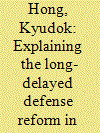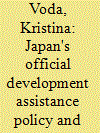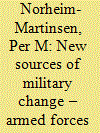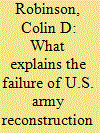|
|
|
Sort Order |
|
|
|
Items / Page
|
|
|
|
|
|
|
| Srl | Item |
| 1 |
ID:
090977


|
|
|
|
|
| Publication |
2009.
|
| Summary/Abstract |
The attempt of the Georgian government to reform and restructure its military forces in the past ten years demonstrates the difficulty of conducting Western-style defense reform in postconflict states, which have not seen a formal end to armed conflict. Western-style reforms were intended to bring Georgia greater peace, stability, and accountability, with the added benefit of training additional soldiers to support regional peacekeeping operations. Domestic political imperatives within Georgia, however, demanded that the government restore the territorial integrity of the state by "reintegrating" South Ossetia, Abkhazia, and Adjara. In this context, additional organizational and doctrinal interoperability of Georgian forces was desirable, but only to the extent that it enabled Georgian forces to meet these primary domestic political requirements. For Georgia, a country with a weak military tradition and unresolved domestic conflicts causing political controversy at home, military reform was not just an abstract step toward democracy but a potential means to an end of resolving those same conflicts by force or threat of force.
|
|
|
|
|
|
|
|
|
|
|
|
|
|
|
|
| 2 |
ID:
147391


|
|
|
|
|
| Summary/Abstract |
This study explains why defense reform efforts in South Korea have failed to achieve substantial progress. The outcome would seem all the more unexpected because the Blue House has ostensibly wanted comprehensive defense reform, while the Korean military is also highly motivated to upgrade itself to be able to fight and defend itself against North Korea, which has continuously threatened to use nuclear weapons preemptively. How should we account for this puzzle? This study focuses on three factors to explain the absence of reform: the role of the president, the opposition from the armed forces leadership, and lapses in the civilian control of the military. This study concludes that South Korea needs to revitalize the reform process in order to successfully confront the security challenges of the twenty-first century. Defense reform has long been dominated by the military leaders. It has resulted in the unwanted situation where civilian leaders have been alienated. Ironically, lack of interest among civilian leaders leads to the lack of support from outside. In order to achieve successful defense reform, assistance from the outside must be guaranteed. South Korea needs to readjust goals and prepare for building robust armed forces to play a decisive role in achieving the mission to meet the requirements of changing strategic environments. The Park administration also needs to take timely steps to overcome its own vulnerabilities, such as modifying its doctrine, equipment, training, and culture. Elimination of its vulnerabilities may involve changes in philosophy, tactics and possibly even modifications to the concepts of operations. All can entail substantial costs. However, the cost of not dealing with the threats is likely to be much higher.
|
|
|
|
|
|
|
|
|
|
|
|
|
|
|
|
| 3 |
ID:
147744


|
|
|
|
|
| Summary/Abstract |
The author analyzes changes in Japan's Official Development Assistance (ODA) policy in terms of maintaining peace and security. She describes the main theoretical approaches to analysis of Japan's development support policy; gives an overview of ODA Charters; observes Japan's efforts toward building up capabilities in the field of defense and security in order to increase Japan's contribution to global development and enhance its influence in international affairs.
|
|
|
|
|
|
|
|
|
|
|
|
|
|
|
|
| 4 |
ID:
108577


|
|
|
|
|
| Publication |
2011.
|
| Summary/Abstract |
Military conscription is a mechanism designed to develop troops and their capabilities,
which are the foundation for creating military strength, and it is inextricably related
to military manpower structure, military management system, and military structure.
Accordingly, we cannot ignore the implications of military service policies for
successful military reform and the transformation of military strength. Since
2006, Korea has been pursuing national defense reforms with a view to shifting
from a troop-focused quantitative military structure to a technology-intensive
military structure and has thus been carrying out a series of military service
reform plans. However, a rapid shift in policy direction and reasonable modifications
and adjustments of the implementation plan are constantly needed since the geostrategic and economic environment surrounding Korea, its demographic and social
environment, military technology development, and global trends in transforming
the military service system, continue to raise new issues related to Korean military
service policy. Modifications of the current military service system that would
allow for the increasing social demand for a change to all-voluntary service, a
review of a differentiated military service system designed to meet the need for the
adjustment of the term of military service for conscripts, the proposal of a reasonable
policy in response to the demands for mandatory military service for women, and
the creation of a plan to incorporate religiously motivated conscientious objectors
into the community service system will be an important part of the military service
policy agenda that national defense policymakers should keep in mind.
|
|
|
|
|
|
|
|
|
|
|
|
|
|
|
|
| 5 |
ID:
148539


|
|
|
|
|
| Summary/Abstract |
This study explains why defense reform efforts in South Korea have failed to achieve substantial progress. The outcome would seem all the more unexpected because the Blue House has ostensibly wanted comprehensive defense reform, while the Korean military is also highly motivated to upgrade itself to be able to fight and defend itself against North Korea, which has continuously threatened to use nuclear weapons preemptively. How should we account for this puzzle? This study focuses on three factors to explain the absence of reform: the role of the president, the opposition from the armed forces leadership, and lapses in the civilian control of the military. This study concludes that South Korea needs to revitalize the reform process in order to successfully confront the security challenges of the twenty-first century. Defense reform has long been dominated by the military leaders. It has resulted in the unwanted situation where civilian leaders have been alienated. Ironically, lack of interest among civilian leaders leads to the lack of support from outside. In order to achieve successful defense reform, assistance from the outside must be guaranteed. South Korea needs to readjust goals and prepare for building robust armed forces to play a decisive role in achieving the mission to meet the requirements of changing strategic environments. The Park administration also needs to take timely steps to overcome its own vulnerabilities, such as modifying its doctrine, equipment, training, and culture. Elimination of its vulnerabilities may involve changes in philosophy, tactics and possibly even modifications to the concepts of operations. All can entail substantial costs. However, the cost of not dealing with the threats is likely to be much higher.
|
|
|
|
|
|
|
|
|
|
|
|
|
|
|
|
| 6 |
ID:
145861


|
|
|
|
|
| Summary/Abstract |
The literature on how European states have adapted to the post-cold war security environment ffocuses invariably on different understandings of military transformation, a process which is seen as inherently different from other forms of organizational change. However, as this paper argues, new management practices, going back to the introduction of so-called New Public Management (NPM) reforms throughout Europe in the 1980s, have eventually penetrated also the last bastion of the old state – the defense sector. Taking a critical approach to the idea of military transformation and existing theories of military change, the paper demonstrates how other international developments have pushed towards what may be seen as a “normalization” of Europe’s defense sectors. This has important implications for how we approach and understand change in contemporary defense organizations.
|
|
|
|
|
|
|
|
|
|
|
|
|
|
|
|
| 7 |
ID:
151395


|
|
|
|
|
| Summary/Abstract |
The Norwegian Armed Forces has seen extensive reforms since the early 1990s. It has been changed from a large, conscription-based, reservist-dominated territorial Defense force to a smaller, more proficient, and flexible force. However, this process has been far from linear, and to this day the Norwegian Armed Forces retains significant elements of its organizational and cultural cold war heritage. We argue that national security concerns, domestic politics and financial constraints have played the main role in shaping the reform of the Armed Forces. This argument gives an alternative to explanations offered by previous research, which has tended to emphasize the role played by international influences, such as the NATO operations in the Balkans and Afghanistan, as well as NATO and US reform initiatives. While external factors undoubtedly have shaped the direction and tempo of the reforms, our findings point to long-standing structural and financial imbalances as the key explanation of the current structure of the Norwegian Armed Forces.
|
|
|
|
|
|
|
|
|
|
|
|
|
|
|
|
| 8 |
ID:
161349


|
|
|
|
|
| Summary/Abstract |
This author wrote his doctorate thesis on post-conflict army reconstruction, submitting it in 2011. Continued research on the subject in the intervening seven years indicates that his theoretical propositions can be refined and improved. This article examines refinements to the model, and then applies those refinements in detail to the Afghan case. In so doing, it shifts the focus from potentially altruistic state-building to a case that was driven by pure national-strategic interests. Issues surrounding the liberal peace ideology dominate recent army reconstruction in conflict-affected states. The liberal peace underpinning is of supreme importance, so much so that in many discussions, it is internalised and accepted virtually without thought. This paper will advance the body of knowledge by establishing, for the first time, a theoretical basis for the widespread failure of army reconstruction in Afghanistan. The empirical basis builds on extensive previous research by other scholars. The resulting model can also be applied to better explain outcomes in other similar cases.
|
|
|
|
|
|
|
|
|
|
|
|
|
|
|
|
|
|
|
|
|